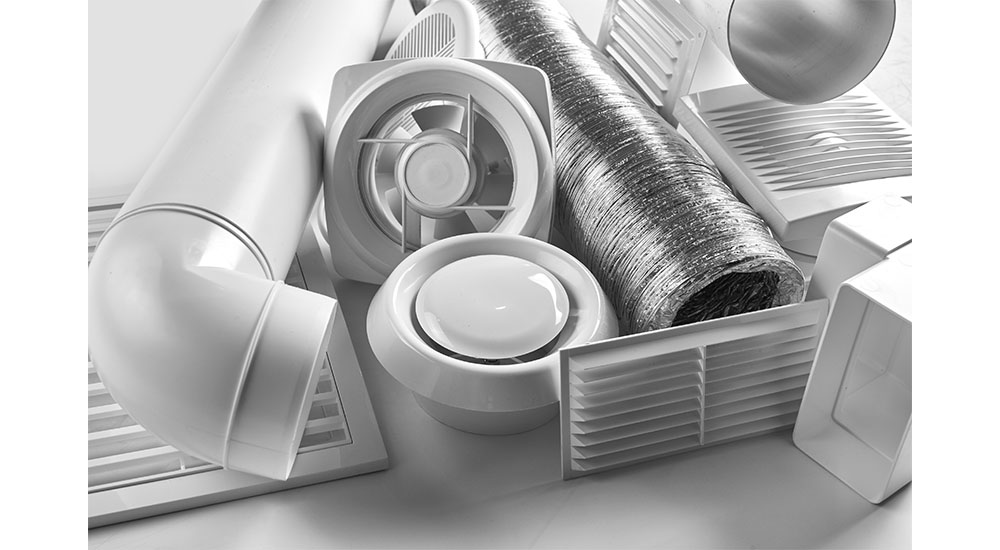Indoor air quality is often overlooked in discussions about health and productivity, yet it plays a crucial role in our daily lives. The quality of the air we breathe can significantly impact our physical and mental well-being, job performance and compliance with building safety standards. An understanding on the importance of IAQ is essential for creating safe, healthy environments. Whether ventilating the bathroom, laundry room or bigger living spaces, a whole-home ventilation strategy is critical to breathing easy.
Creating Healthier Indoor Environments
Ventilation is a key solution to maintaining healthy indoor air quality. It involves replacing stale indoor air with fresh outdoor air, diluting pollutants and improving air quality. Effective ventilation systems help control humidity levels and reduce the concentration of indoor contaminants.
Bathroom ventilation plays a crucial role in this process. It specifically targets the unique challenges of moisture and odors that often accumulate in these spaces. Proper bathroom ventilation can significantly reduce humidity, preventing the potential growth of mold and mildew, which can negatively impact both health and structural integrity. Additionally, effective ventilation helps eliminate unpleasant odors, contributing to a more pleasant atmosphere in the entire home.
Mechanical systems, such as ventilation fans, energy recovery ventilators, purification systems and HVAC units with filtration capabilities, significantly enhance air quality by filtering harmful particles. Natural ventilation, such as opening windows, can also improve IAQ, especially in areas with relatively clean outdoor air. Today’s homes are built more tightly, and whole-home ventilation strategies, including dedicated bathroom ventilation, are increasingly important for circulating air effectively.
A well-ventilated environment contributes to lower rates of respiratory illnesses and promotes physical health. In bathrooms specifically, reducing moisture and pollutants leads to cleaner air and a healthier living space.
IAQ’s Connection to Physical & Mental Health
Poor indoor air quality can lead to respiratory issues like asthma, allergies and chronic obstructive pulmonary disease. Common pollutants such as mold, dust mites, pet dander and volatile organic compounds can exacerbate these conditions, leading to symptoms such as fatigue and headaches. Studies show that individuals exposed to poor IAQ are more likely to experience mental stress, further compromising their overall well-being.
The relationship between indoor air quality and mental health is also gaining attention. Poor air quality can lead to symptoms of anxiety and depression, exacerbating stress. In contrast, improved IAQ through effective ventilation is linked to better mood and cognitive performance. Research from the Harvard T.H. Chan School of Public Health shows that workers in well-ventilated environments exhibit higher cognitive function scores compared to those in spaces with inadequate ventilation.
Productivity and Performance
Indoor air quality significantly influences workplace productivity. Employees spend a large portion of their lives indoors – whether working from home or in an office, and the conditions of these environments directly affect their efficiency and creativity. Poor air quality can lead to decreased concentration and increased fatigue, which hinders performance.
Furthermore, when air quality is compromised, employees may be more prone to illness, leading to higher absenteeism. Investing in ventilation systems can help reduce these absences, benefiting an organization’s bottom line. Healthy and comfortable employees are less likely to miss work, improving team collaboration and continuity.
Adherence to Compliance & Safety Standards
Indoor air quality is also critical for compliance with safety standards. Governments and health organizations have established guidelines to ensure indoor environments are safe. Compliance not only protects residents and employees but also reduces legal liabilities for businesses.
In 2024, the International Energy Conservation Code introduced new regulations for multifamily buildings that emphasize improved ventilation standards. These updates mandate enhanced ventilation measures to ensure indoor air quality, promoting healthier living environments. Proper implementation of these codes ensures compliance and contributes to the well-being of occupants.
Failing to meet air quality standards can lead to significant consequences, including fines and reputational damage. Regular assessments and improvements to indoor air quality, particularly through proper ventilation, are essential for compliance with safety regulations.
Maintaining good indoor air quality through effective ventilation is a proactive risk management strategy. Ensuring spaces are free from harmful pollutants minimizes the risk of respiratory issues and allergies.
In residential settings, good indoor air quality is vital, especially for children and the elderly, who are more susceptible to the effects of poor air quality. In professional settings better IAQ fosters healthier work environments to help boost employee morale. Implementing measures to improve IAQ in homes – such as regular cleaning, using non-toxic materials and ensuring adequate ventilation – can lead to healthier living conditions.
IAQ Is No Longer an Afterthought
The significance of indoor air quality cannot be overstated. It impacts our health and well-being, shapes productivity and ensures compliance with safety standards. Prioritizing ventilation and IAQ, individuals and organizations will create healthier environments that foster well-being and performance.
As we spend more time indoors, understanding and improving indoor air quality is critical for our well-being. Investing in air quality improvements – including effective ventilation systems – is not just about compliance; it’s an investment in human capital and quality of our lives. Let us recognize the profound impact of the air we breathe in every room in our homes.
—By Russell Pope, Industry Development Manager, Panasonic Eco Systems North America








